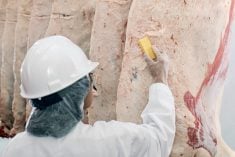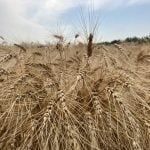Cattle producers throughout North America know that sufficient moisture is critical for running their operations. Whether it be in the form of rain or snow, moisture allows grass to grow for grazing and for making hay. It allows crops to grow that feed cattle on the ranch or in the feedlot. It also allows ranchers to have adequate water supplies year-round for their cattle.
It was thus with a deep sense of relief that U.S. ranchers, particularly in the western half of the country, saw timely and often heavy rains from December through February. The rains have helped reduce the area of cow-calf country that is under drought conditions.
Conditions in California were extreme last fall, with 100 per cent of the state in drought. But now only 49 per cent of the state is in drought, a remarkable improvement. Much larger rainfall up until now and a huge snowpack in the Sierra Mountains mean that most ranchers will enjoy ample water supplies this year. However, those relying on aquifers will be less well off, as aquifers take years to recover.
Read Also

The Canadian Cattle Association’s international advocacy efforts
Global ag policies affect Canadian food policy, so the Canadian Cattle Association participates in international and domestic forums
Sustained moisture is critical to ending herd liquidation and for beginning the herd rebuilding process in earnest, says Andrew Gottschalk of HedgersEdge.com. A comparison of recent data versus the same period in 2022 provides a view of an improved drought situation, given recent moisture. Only 48 per cent of the cattle inventory remains in areas posting varying degrees of drought, versus 62 per cent last year. The feeder cattle and calf markets are entrenched in the next phase of a bull market, he says. Feeder cattle and calf prices are trading at the low end of their respective up-trending channel versus fed cattle prices. But significant price gains are expected for feeder cattle prices, he says.
The nationwide drought is and has been affecting inventories and has been having the greatest effect on states with the largest numbers, says Katelyn McCullock of the Livestock Marketing Information Center. The January 1 cattle inventory report revealed that Oklahoma showed an 11.5 per cent year-on-year decline in cattle numbers, while North and South Dakota showed 6.4 per cent and 6.6 per cent reductions, respectively, she says.
A second positive for U.S. cow-calf operators is that cattle markets have responded to smaller cattle numbers by reporting sharply higher prices than a year ago. The average price of a 600- to 750-pound Georgia feeder steer in late February was US$185.36 per cwt, which was up 21 per cent on the same week last year. The average price of a 700- to 750-pound Oklahoma City steer was US$190.40 per cwt, up 19 per cent on the same week last year. Not to be outdone, live fed steer prices the same week averaged US$163.72 per cwt, up 14.3 per cent on the same week last year.
The latest cattle-on-feed report confirmed that feedlot numbers are declining and that cattle feeders can expect firm to higher prices for much of the year. Placements of cattle into feedlots in January declined 72,000 head or 3.6 per cent versus a year earlier, marking the fifth successive month of lower placements. The cumulative decline in placements since last September was 559,000 head.
Front-end fed cattle supplies will begin to decline sharply relative to last year during May, says Gottschalk. Provided estimated marketing levels are achieved, the decline from the March 1 estimate to the July 1 estimate is projected to be 217,000 head. This is in sharp contrast to last year and the previous five-year average, when front-end supplies increased by 78,000 head and 279,000 head, respectively, he says. That is why cattle feeders will enjoy strong prices this year.
















